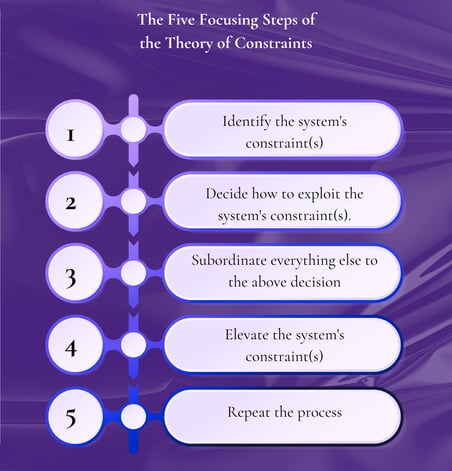The Five Focusing Steps of the Theory of Constraints Explained
OPERATIONS MANAGEMENTCHANGE MANAGEMENTPRODUCTIVITYSTRATEGIES
Vivian Ubochi
6/18/20244 min read


In today's fast-paced and competitive business environment, organizations constantly strive to improve efficiency, reduce bottlenecks, and achieve operational excellence. One of the most effective methodologies to accomplish these goals is the Theory of Constraints (TOC). This powerful management philosophy was introduced by Dr. Eliyahu M. Goldratt, an Israeli physicist turned business consultant, who introduced the concept in his 1984 novel, "The Goal”.
At its core, TOC is based on the premise that every system has at least one constraint that limits its performance. By identifying and managing this constraint, organizations can achieve significant improvements in their overall output. The Five Focusing Steps, also known as the Process of Ongoing Improvement (POOGI), provide a structured approach to systematically address these constraints.
The Five Focusing Steps
Identify the Constraint The first step in the TOC process is to identify the system's constraint. This is the most critical factor that limits the organization's ability to achieve its goals. Constraints can take various forms, such as physical bottlenecks in production, resource limitations, market demand, or even organizational policies. For instance, in a manufacturing plant, a constraint could be a particular machine that is slower than others, causing delays in the production line. By pinpointing this limiting factor, organizations can focus their efforts on addressing the root cause of inefficiencies.
Exploit the Constraint Once the constraint is identified, the next step is to exploit it to its fullest potential. This involves optimizing the use of the constrained resource to ensure it operates at maximum efficiency. In the case of a bottleneck machine, this might mean reducing downtime, minimizing setup times, or scheduling work to keep the machine running continuously. The goal is to ensure that the constraint is not wasted and that its capacity is fully utilized.
Subordinate Everything Else to the Constraint In this step, all other processes and resources within the organization are aligned to support the optimal operation of the constraint. This may require adjusting schedules, reallocating resources, or changing priorities to ensure that the constraint remains the focal point. For example, if a particular machine is the constraint, other machines and processes should be scheduled to ensure a smooth flow of work to and from the bottleneck, preventing any delays or idle time.
Elevate the Constraint If the previous steps have been exhausted and the constraint still limits the system's performance, the next step is to elevate the constraint. This involves making significant changes or investments to increase the capacity of the constrained resource. In a manufacturing context, this could mean purchasing additional machinery, hiring more skilled workers, or implementing new technologies. The objective is to break the constraint and enhance the system's overall capacity.
Repeat the Process TOC is a continuous improvement process. Once the initial constraint is addressed, the focus shifts to identifying and managing the next constraint. This iterative cycle ensures that organizations constantly improve their performance by systematically eliminating bottlenecks. The process of ongoing improvement helps organizations adapt to changing conditions and maintain a competitive edge.
In Dr. Eliyahu M. Goldratt’s book, "The Goal", he provided a fictional yet insightful case study on the application of TOC. The protagonist, Alex Rogo, manages a manufacturing plant struggling with late orders, high inventory, and declining profits. Through his mentor Jonah, Alex learns to identify and manage constraints using the Five Focusing Steps.
For example, Alex discovers that a particular machine, the NCX-10, is the bottleneck in his production line. By applying the Five Focusing Steps, he optimizes the use of the NCX-10, aligns other processes to support its operation, and eventually invests in additional capacity. As a result, the plant's performance improves dramatically, orders are completed on time, and profitability is restored.
The Theory of Constraints has been successfully applied in various industries, demonstrating its versatility and effectiveness. One notable example is the case of General Motors (GM). In the early 1990s, GM's Lansing plant faced significant production inefficiencies and quality issues. By implementing TOC principles, the plant management identified key bottlenecks and optimized their operations accordingly. This led to a substantial increase in productivity, reduced lead times, and improved product quality.
Another well-documented case is that of Boeing, one of the world's leading aerospace manufacturers. Faced with production delays and cost overruns in the 1990s, Boeing applied TOC to streamline its manufacturing processes. By focusing on key constraints and aligning their resources accordingly, Boeing was able to significantly reduce production cycle times and enhance overall efficiency. This transformation played a crucial role in the successful launch of the Boeing 777 aircraft.
While the Theory of Constraints offers a powerful framework for improving operational efficiency, its implementation can present challenges. One common challenge is resistance to change. Employees and managers may be hesitant to adopt new processes or prioritize constraints over other tasks. To overcome this, organizations can emphasize the benefits of TOC through training and clear communication.
Another challenge is accurately identifying the true constraint. Misidentifying the bottleneck can lead to wasted efforts and resources. Conducting thorough process analysis and involving cross-functional teams can help in correctly pinpointing the constraint.
As demonstrated in "The Goal" and real-world cases like General Motors and Boeing, the application of TOC can lead to significant improvements in productivity, quality, and profitability. By embracing the Five Focusing Steps and committing to continuous improvement, organizations can navigate the complexities of today's business landscape and achieve sustainable success. From manufacturing plants to service industries, the principles of TOC have proven to be versatile and impactful. In essence, the TOC and its Five Focusing Steps provide a pragmatic, logical framework for organizations to identify their weakest links and systematically improve them, thereby unlocking their full potential for growth and success.
© 2024 Gooro Consulting
All Rights Reserved.



